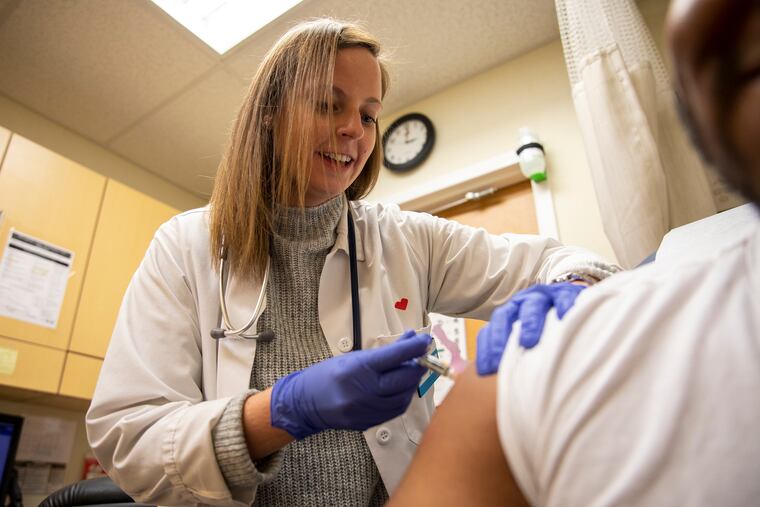Flu’s first wave is easing in Pa., N.J. But wait!
Public health authorities say we could see another round of illness before this unusual season ends.

It may seem like everyone you know is sick, but the official reports show that flu season is getting a little better in New Jersey, Pennsylvania, and the nation as a whole.
Don’t relax yet, though. This has been an unusual flu season, and public health authorities said we might still face another serious round of illness if different strains of the virus take off.
So they’re sticking by their usual advice this time of year: It’s not too late to get the flu shot, even though it takes two weeks for the vaccine to become fully effective. Flu season usually lasts a lot longer than a couple of weeks from now.
“It’s still January,” said Tina Tan, state epidemiologist for the New Jersey Department of Health. “It’s hard to predict what’s going to happen in the next several weeks.”
Kelly Moran, a nurse practitioner who works at a MinuteClinic in the CVS at 15th and Spruce Streets in Philadelphia, said she has not seen a slowdown in cases. “We’ve definitely seen a peak in the last two or three weeks,” she said.
» READ MORE: Will antiviral drugs help your flu symptoms? Maybe.
In its weekly report on the flu season, the U.S. Centers for Disease Control and Prevention said that reports of influenza-like illness and laboratory data showed a slight decline during the week ending Jan. 11. While activity remained high, measures of flu severity, including hospitalizations and deaths, were not high for this time in the season compared with past years, the CDC said. The level of flu-like cases declined to moderate levels in Pennsylvania but remained high in New Jersey. With the exception of Washington, D.C., Oregon, and Hawaii, flu was considered widespread, a measure of geographic spread within states throughout the country.
New Jersey reported a second pediatric death from flu. Tan said the state typically has one to three flu deaths among children each year, though fatalities were higher in the past two seasons. (New Jersey does not report adult flu deaths.) The national total of pediatric deaths for the season so far is 39.
Pennsylvania has reported 24 adult flu deaths this season — none among children — and 688 flu-associated hospitalizations. The CDC estimates that there have been 120,000 hospitalizations nationally because of flu and 6,600 deaths.
Flu virus can come in many forms. Scientists categorize strains of the virus into two families, A and B. Usually A strains, which are often associated with more serious illness, are the lead-off hitter in a season and B strains emerge in March, Tan said. While B strains can make any individual just as sick as A strains do, they tend to lead to fewer deaths and hospitalizations because they are more likely to sicken younger, stronger people.
This year, a B strain called Victoria took off early and has overshadowed type-A flu. This year’s flu shot protects against a version of B/Victoria, but there is evidence that some B/Victoria now circulating is somewhat different than the strain in the shot, Tan said. The CDC does not release its annual report on vaccine effectiveness until February.
Moran said she is seeing patients who have had the shot and still test positive for flu, but those who’ve been vaccinated tend to have milder symptoms than those who have not.
The latest reports show a drop in flu overall, including B/Victoria. But reports of A strains are picking up. The flu season typically doesn’t end until spring, so there’s still a chance for another bump in activity.
There are also other respiratory viruses circulating that can be mistaken for flu: respiratory syncytial virus (RSV), coronavirus, parainfluenza, adenovirus, human metapneumovirus, and rhinovirus. Most of those are on the decline, according to the New Jersey report, but coronavirus may be on a slightly upward path.
In most people, these other viruses tend to be milder than flu. “Flu is much more acute, a little bit more severe in presentation,” Tan said.
Moran said sudden onset of symptoms is a hallmark sign of flu. “People can usually tell me the minute it started because it hit like a ton of bricks,” she said. Symptoms include fever and body aches, cough, headache, and sore throat.
New Jersey is still seeing an increase in school absenteeism and hospitalizations for flu-like illnesses after emergency department visits, but Tan said it is hard to know whether flu is actually to blame.
Moran had some simple advice for weathering the rest of the flu season: “Get your flu shot and wash your hands” and “if you’re sick, stay home.”